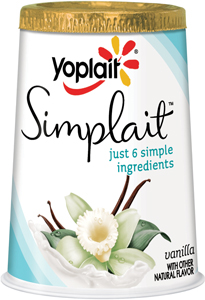
|
|
The label on this new yogurt from Yoplait has just six ingredients. |
In today’s world, where health and wellness takes center stage, the subject of functional cultured dairy foods typically are about consumption of the probiotic bacteria and their associated health benefits, such as improved immune function, improved digestive function and reduction of symptoms associated with irritable bowel syndrome. (For more on the health benefits associated with probiotics see www.usprobiotics.org.)
In other words, the term “functional” is usually in reference to a “functional food” which describes foods that provide benefits (from a nutrition science viewpoint) beyond the basic nutritional value of the food components.
Most consumers will only continue to consume foods when they provide satisfaction from a sensory viewpoint in a way that fits their lifestyles and price/value targets.
Sometimes, in all the hoopla and scramble to put out the next super-duper cure-all food, we overlook that eating food needs to generally be a pleasurable experience. And in order for a food company to maintain a profitable business, the food must withstand the rigors of processing, distribution, storage and consumer abuse. So, the components of the food must perform or have desired functional properties (from a food science viewpoint).
Gelation, viscosity control
The end point of fermentation of many of cultured dairy products is reached at or near the pH of 4.6. When properly formulated and processed, the caseins of this fluid milk system undergo controlled aggregation during fermentation — as a result of lactic acid production — to form a relatively stable soft viscous gel with good water-holding capacity. When properly maintained and/or stabilized, this soft gel can form the necessary structural matrix for a semi-solid food product or be blended with other food ingredients to provide a smooth creamy mouthfeel/texture.
Food manufacturers can often take advantage of this property and use cultured skim milk as a fat mimetic in reduced-fat or fat-free foods.
When the food application or process demands higher stability, the selection of cultures with a natural boost of stabilizer — due to exopolysacharride (EPS) production — can provide extra desirable textural properties. In addition, such fermented milk systems containing EPS can allow some improved heat stability, greater viscosity and improved texture for some situations. These functional properties can be very valuable in some food applications to reduce or prevent phase separation during product storage. They can reduce dense particle sedimentation, and/or light phase particle creaming while providing desired textural properties to the food.
Flavor and shelf life
When heterofermentative cultures are used properly for the production of fermented dairy foods, the final products contain diacetyl, which provides a nice buttery flavor note. This buttery note can provide richness and balance to any dairy system or to other systems where such a flavor profile is desired. Skim milk fermented with these cultures turns it from a subtle flavored fluid milk beverage to a buttery, slightly viscous, slightly tart cultured buttermilk.
Several lactic cultures are known to produce natural antimicrobials (bacteriocins), which can inhibit the growth of other spoilage or pathogenic organisms. Hence, by incorporating cultured dairy products, the metabolic products of their fermentation can be used to extend the shelf life of food systems. Additionally, the live bacterial cultures in the cultured dairy products and other metabolic products of fermentation contribute additional hurdles to the outgrowth of spoilage and pathogenic organisms.
Label friendly
One special and important advantage to using these cultured dairy products for their functional properties is that they are label friendly. First, they are made from milk and other label-friendly ingredients. And second, in many cases, the only other ingredient is the lactic acid bacteria used for the fermentation.
Recognizing and fully realizing the functional performance of cultured dairy products in food applications can help insure a consumer-friendly food that tastes good, looks good and delivers the desired consumer price/value, while providing some health and wellness benefits, too.



